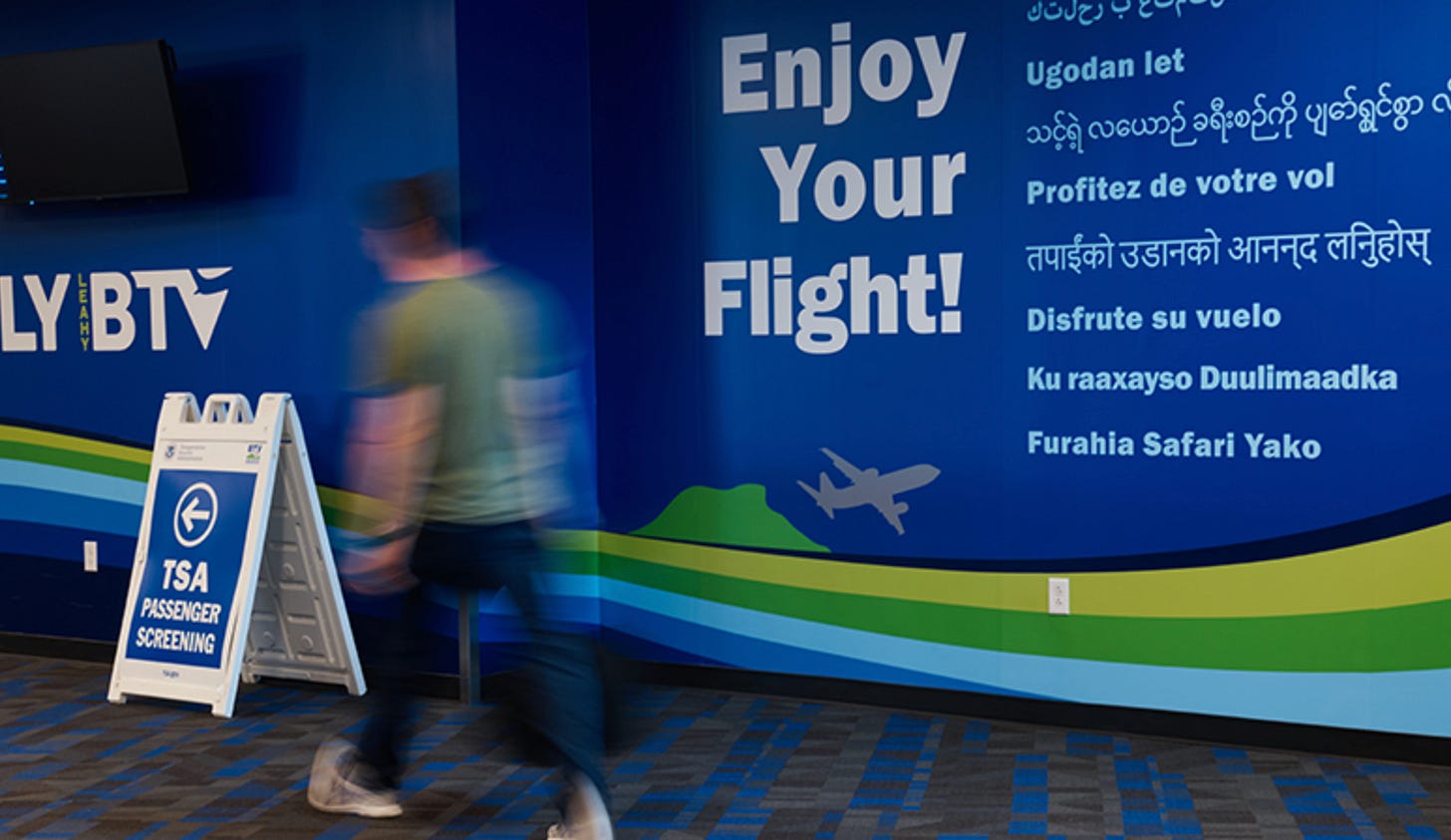Cancellations Hit Vermont on Day 1 of FAA Cuts
An overwhelming 78% of BTV’s non-stop routes are now flying into capacity-constrained airports, meaning the core corridors connecting Vermont to the national grid are all compromised.
If you are traveling through Patrick Leahy Burlington International Airport (BTV) today, you may be facing disruptions. As of November 7, 2025, an American Airlines flight to Philadelphia has been canceled, while Delta and United flights to Atlanta and Newark are experiencing delays.
These are not random issues. They are the first local impacts of an “unprecedented” emergency order from the Federal Aviation Administration (FAA) to reduce national air traffic. This report explains what the order is, why it’s happening, and what it means for Vermont residents.
What is the FAA Order and Why Is It Happening?
The FAA, along with the U.S. Department of Transportation, has ordered a mandatory reduction of flights at 40 “high-volume” airports across the country.
The root cause is the ongoing U.S. government shutdown. Air traffic controllers (ATCs) are essential employees who have been working without pay for over a month, with many now facing their second missed paycheck. This has led to extreme fatigue, financial strain, and an increase in controllers calling out, worsening existing staffing shortages.
The FAA has stated this order is a proactive safety measure. Agency data shows an increase in critical errors, such as “more breaches” of the minimum safe-flying distance between aircraft. FAA Administrator Bryan Bedford stated the system was at a point where it could “no longer operate at full capacity without risking errors”. The flight cuts are not the problem; they are the FAA’s solution—a mandatory “throttling” of the system to reduce the workload on controllers to a level that can be managed safely.
How the 10% Cut Works
The order, which began today, November 7, is being phased in to prevent a total shock to the system. The 10% reduction figure cited in many reports is the final goal, not the immediate impact.
The ramp-up schedule is as follows:
November 7 (Today): A 4 percent reduction takes effect.
November 11 (Tuesday): Reductions increase to 6 percent.
November 13 (Thursday): Reductions increase to 8 percent.
November 14 (Friday): The full 10 percent reduction will be in effect.
This means the delays and cancellations seen today are based only on the initial 4% cut.
Why BTV is Affected (Even Though It’s Not on the List)
Patrick Leahy Burlington International Airport (BTV) is not one of the 40 airports on the FAA’s reduction list. However, BTV’s operations are critically exposed.
BTV functions as a “spoke” airport. For legacy carriers like American, Delta, and United, its main role is to feed passengers from Vermont to their major “hub” airports.
A detailed analysis confirms that 14 of BTV’s 18 non-stop destinations are “high-volume” hubs on the FAA’s mandatory reduction list.
These affected destinations include:
Atlanta (ATL)
Charlotte (CLT)
Chicago (ORD)
Denver (DEN)
Detroit (DTW)
Newark (EWR)
New York-LGA
Orlando (MCO)
Philadelphia (PHL)
Tampa (TPA)
Washington DC-Reagan (DCA)
An overwhelming 78% of BTV’s non-stop routes are now flying into capacity-constrained airports, meaning the core corridors connecting Vermont to the national grid are all compromised.
“Regional Flying” Is the First to Be Cut
The 10% reduction is not being applied evenly. Airlines are making strategic decisions to protect their most critical and profitable routes, which are typically “hub-to-hub” (e.g., Chicago to Los Angeles).
United Airlines has been explicit about its strategy, stating it “will focus our schedule reductions on regional flying”. A flight from BTV to Chicago is the exact definition of this “regional flying.” This means flights from “spoke” airports like BTV are at the highest risk of being cut.
The disruptions at BTV today are a direct result of this strategy:
American 5458 to Philadelphia (Canceled): Philadelphia (PHL) is a major American Airlines hub and is on the FAA reduction list. This flight is a “textbook” cut of a regional route to reduce the load at the constrained PHL hub.
Delta 2450 to Atlanta (Delayed): Atlanta (ATL) is on the reduction list. The FAA is using “ground delay programs” to hold planes at their origin (BTV) because the under-staffed Atlanta airspace cannot safely accommodate the flight on time.
United 4476 to Newark (Late): Newark (EWR) is a constrained hub on the list. This flight is de-prioritized as “regional flying” to protect United’s larger flights.
What Happens Next
The disruptions seen today are only the beginning. As of 9:00 a.m. Friday, airlines had already canceled more than 800 flights nationwide, four times the number from the previous day.
Airlines are currently benefiting from a “false comfort” because early November is a “slower season for travel.” With more empty seats, they can rebook passengers from canceled flights onto other flights.
This rebooking buffer is set to evaporate. The situation involves two colliding trends:
Decreasing Capacity: The FAA’s flight cuts will ramp up to the full 10% by November 14.
Increasing Demand: The 10% cut will be fully in effect just as the Thanksgiving travel period... begins.
This will create a “tipping point.” When the 10% network reduction (projected to affect 3,500 to 4,000 flights daily) collides with 100% full planes for the holiday, the system will break.
For BTV travelers, this means airlines will likely make the strategic decision to cancel 100% of service on their least profitable regional routes (such as BTV-Philadelphia or BTV-Chicago) for days at a time. This will allow them to protect their fully-booked, high-profit hub-to-hub flights. In this scenario, rebooking will likely not be an option, as all remaining flights will be full.



